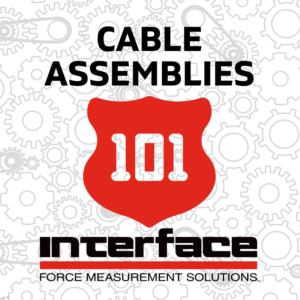Interface Cable Assemblies 101
 Force measurement cables and connectors are far more integral than a cable. Unlike cables for many electronics, they are not just power or data transfer sources. Instead, cables and connectors play a significant role in the total force measurement systems.
Force measurement cables and connectors are far more integral than a cable. Unlike cables for many electronics, they are not just power or data transfer sources. Instead, cables and connectors play a significant role in the total force measurement systems.
Specific cables and mating connectors are used for different applications, environments, frequency and power requirements, and paired measurement devices. This includes sensor considerations as well as instrumentation.
What are cable assemblies?
A cable assembly for a load cell essentially acts as the lifeline between the load cell and the analog output instrumentation, transmitting the electrical signals generated by the load cell to be interpreted and measured. It’s not just a simple cable but a carefully constructed unit designed to maintain signal integrity and protect against external interference.
Interface cable assemblies are used for connecting transducers to instrumentation. Our cable assemblies are designed for easy integration with Interface measurement devices and instrumentation. Interface cables maintain the specification of the product. We provide standard cable assemblies and custom lengths, depending on your application. Shielded cables are available from Interface. Our line of cables is part of the diverse line of Interface Accessories.
Cable Assembly Basics
- Shielding protects the signals from noise and ensures accurate readings.
- Twisted pairs are individual conductor pairs twisted together to reduce noise interference and crosstalk between signals.
- The material and gauge are chosen to minimize voltage drop and signal loss over the cable length.
- Durable jackets protect the internal components from physical damage and environmental factors like moisture and abrasion.
- Mating connectors should be compatible with the load cell and instrumentation, often sealed to prevent moisture ingress.
- Strain relief prevents damage to the cable near the connectors from pulling or moving.
- Proper shield grounding is crucial for effective noise mitigation.
In essence, a load cell cable assembly is engineered to ensure the fidelity and accuracy of the load cell’s signal, ultimately contributing to reliable and precise measurements in your system. Remember, the specific design and features of the cable assembly can vary depending on the type of load cell, application requirements, and environmental considerations. C
Essential Tips for Selecting a Cable
- Length: One of the most critical considerations when selecting the suitable cable for your application is cable length. Minimize cable length to reduce signal loss and maintain accuracy. Consider the extra length needed for routing flexibility; however, it is not recommended to use extra long cables if it is not necessary.
- Temperature range: Ensure the cable is rated for your environment’s expected operating temperature range.
- Moisture resistance: Consider waterproof cables for outdoor or wet environments to prevent corrosion and signal degradation.
- Flexibility: Choose a cable with appropriate flexibility for your installation. Stiffer cables are more durable but more challenging to maneuver in tight spaces.
- Shielded or unshielded? Choose shielded cables in environments with electrical noise from motors, power lines, or radio frequencies. Unshielded cables are sufficient for cleaner environments.
- Twisted pair or single conductor? Use twisted pairs for improved noise rejection, especially in long cable runs. Single conductors are cheaper but more susceptible to interference.
- Number of conductors: Match the number of conductors to your load cell configuration. 4-wire for basic setups, 6-wire for advanced measurements. Consult with your application engineer to define your requirements.
TIP: For constant voltage excitation, two effects of significance can affect accuracy. An effect on the sensitivity due to voltage drops over the cable length. An effect on the thermal span characteristics of the load cell due to the change of cable resistance with temperature.
Cable Length Effects
If the load cell is purchased with a cable of any length, the sensitivity is determined with the installed cable in calibration, and this is not a problem. For load cells with connectors, or if a cable is added that is not designed for the exact use, there will be a loss of sensitivity of approximately 0.37% per 10 feet of 28 gauge cable and 0.09% per 10 feet of 22 gauge cable. This error can be eliminated if a six-wire cable is run to the end of the load cell cable or connector and used with an indicator with sense lead capability.
Temperature Effects
Since cable resistance is a function of temperature, the cable response to temperature change affects the thermal span characteristics of the load cell cable system. For 6-wire systems, this effect is eliminated. For 4-wire cables, the effect is compensated for in the standard cable lengths offered with the load cells if the load cell and cable are at the same temperature simultaneously. For non-standard cable lengths, there will be an effect on thermal span performance. The impact of adding 10 feet of 28 gauge cable is to cause a decrease in sensitivity with a temperature equal to 0.0008%/°F. For an added 10 feet of 22 gauge cable, the effect is to decrease the sensitivity by 0.0002%/°F. In some cases, it is tolerable to degrade performance since Interface standard specification is extremely tight. However, this can be a significant factor for long cable runs or high-accuracy applications. The best way to eliminate the problem is to run six wires to the end of the standard cable length and sense the excitation voltage.
Wireless Versus Cable Key Considerations
- Type of Sensor – is there a wireless option?
- Type of Sensor Output
- Communication Protocol
- Accuracy Impact
- Types of Errors Subject to Wireless Devices
- Servicing Limitations with Power (Battery)
- Line of Sight for Wireless
- Data Rate Can Decline with Wireless Transmissions
- Synchronization of Data
With a growing demand for wireless solutions, it is crucial to consider the results and environment before cutting the cable.
The application is vital in your cable evaluation. With a growing demand for wireless solutions, it is essential to consider the results and environment before cutting the cable. With an increasing demand for wireless solutions, it is vital to consider the results and environment before cutting the cable. Not all cables are the same. We can look at the oil and gas industry as an example of specific cable considerations. We have many oil and gas industry customers who need force measurement solutions to deal with the heat and pressure in a downhole application. The cables and connectors for this project often need custom braiding and coating to ensure the wiring won’t melt or corrode in this environment. We also have submersible solutions in which the connection between the submersible load cell and the connector must be sealed tightly to prevent water damage to the components.
At Interface, our accessories use only the highest-quality components and materials. Our engineers will also work with you to find the accessories that fit your needs. We can work with you to create a custom solution if we don’t offer the necessary connectors and cables in-house. We also provide various options depending on the data requirements, whether permanent monitoring or portable solutions, and different cables based on data type for the type of instrument.
To learn more about our cables, visit our accessories.
ADDITIONAL RESOURCES
Understanding Cable Length and Temperature Effects
Force Measurement Accessories 101
Accessories-Brochure-2







